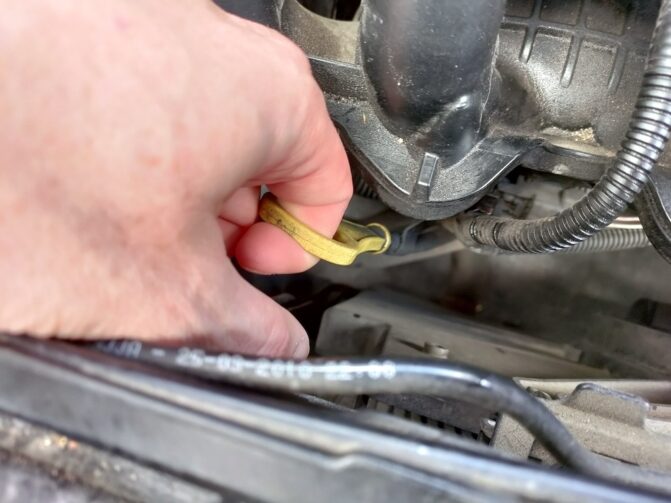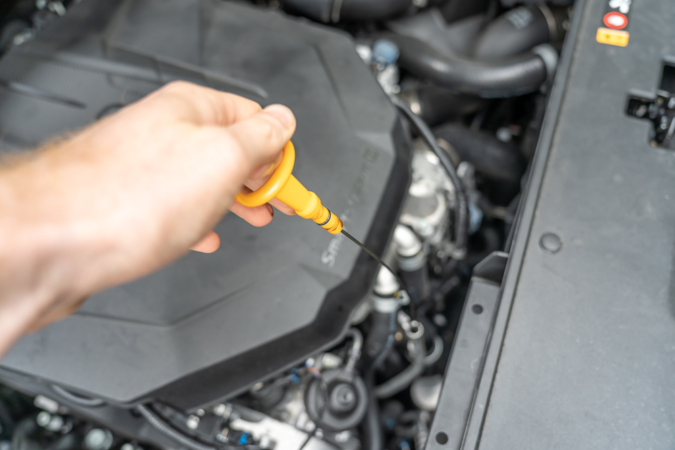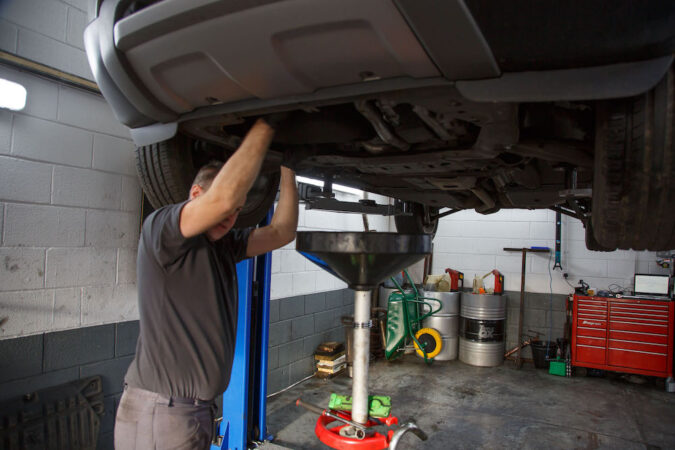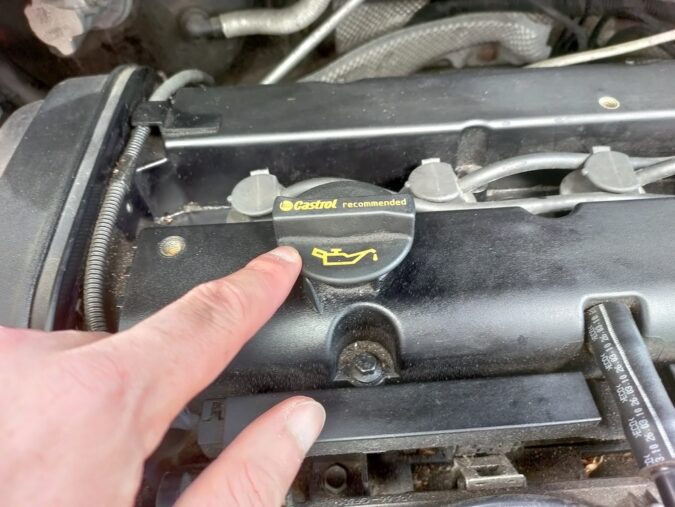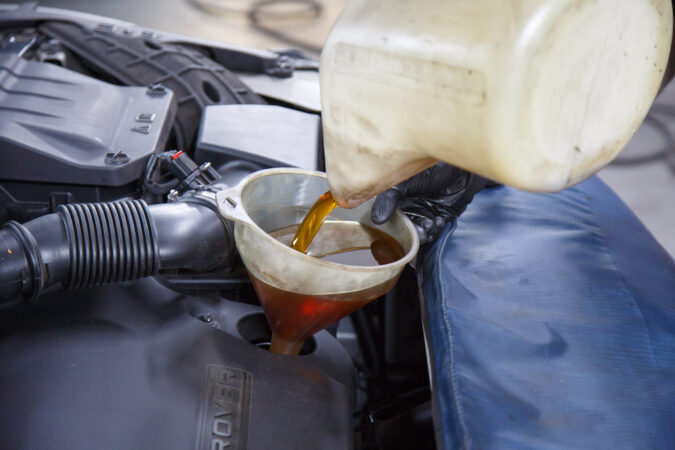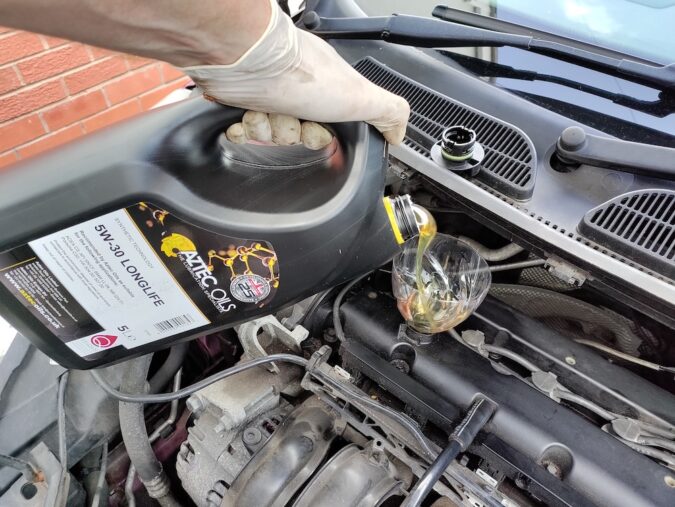If the engine is the heart of your car, then the engine oil that flows through is its lifeblood. In fact, the comparison with blood is quite fitting, as too much or too little engine oil can do more harm to the engine than good. Due to this reason, knowing the exact oil level of your engine is quite important. Every car on the road is equipped with a dipstick for this exact purpose. But, where should oil be on dipstick? If you aren’t sure about that, don’t worry. We’ve got you covered!
Knowing how to observe the dipstick is an essential skill that every car owner should have. Not knowing the exact oil level can lead to severe engine issues, which may sometimes end up costing thousands of dollars. In this article, we’ll tell you all other is to know about measuring the engine oil level. So, with that in mind, let’s get started.
What Is The Purpose Of Engine Oil
Before talking about where should oil be on dipstick, it is important for you to understand why it is so important for your vehicle. Engine oil is responsible for keeping your engine healthy and running at its optimum level. Several key activities performed by oil inside the engine include,
- Lubricating The Internals
- Provide Cooling
- Cleaning The Engine Components
- Sealing The Pistons And Cylinders
- Protecting From Corrosion
1. Lubricating The Internals
One of the most critical activities performed by engine oil is lubricating the internal components. This reduces the friction between the internal parts, extending their lifespan. Not only that, but proper lubrication also ensures that the internal parts don’t get damaged. This reduces maintenance costs, while simultaneously increasing the engine performance.
2. Provide Cooling
As an engine runs, the temperature inside it increases massively. Although there is a cooling system designed specifically to reduce this temperature, it can only cool specific parts. This is where the engine oil comes in handy. It absorbs some heat from the internal components and dissipates it, reducing the temperature in the process.
3. Cleaning The Engine Components
Another purpose of oil is to clean the internal components of the engine. You see, as an engine runs, carbon and other minute substances get built up inside it. Over time, these small particles clog the internals which reduces the performance.
Engine oil does a great job of breaking up these clogs. As the oil passes through the engine, it picks up these particles and carries them to the oil filter. There, the residue gets trapped inside the oil filter, removing them from circulation.
4. Sealing The Pistons And Cylinders
Engine oil acts as a layer of protection between different engine components. This is especially true in the case of pistons and cylinders. Here, the engine oil makes sure that the parts are properly sealed and functioning properly.
5. Protecting From Corrosion
Vehicle engines are made using metallic components. As time goes on, these parts run the risk of corroding. Engine oil acts as a barrier to corrosion by reducing the friction between the parts and keeping them lubricated. Additionally, having the proper amount of oil in the engine also reduces maintenance costs too.
Although oil is important to an engine, having too much of it is an invitation to disaster. Do you want to know what happens when an engine has too much oil in it? If so, follow along!
Too Much Oil In Car
If you don’t know where should oil be on dipstick, you run the risk of overfilling the engine. The oil pan of a vehicle is designed by the manufacturer to only hold a specific amount of oil after taking many factors into consideration, and exceeding this limit can result in catastrophic damage to engine components.
There are a number of symptoms that may help you identify when there is too much oil in the engine. Dense white smoke coming from the exhaust is one such example. This is mainly caused due to the burning of excess oil inside the engine.
Oil leaks from the engine are another indication of overfilling. However, a loose oil drain plug can be the culprit behind the oil leaks as well. But, the best and easiest way to identify whether you have overfilled the engine with oil is by using the dipstick. We will tell you exactly where should oil be on dipstick later in this article.
Some of the most significant problems caused by overfilling engine oil include,
- Spark Plug Failure
- Engine Damage
- Excessive Pressure On Crankshaft
1. Spark Plug Failure
Spark plugs are what ignite the fuel-air mixture inside the engine. But when there is an oil leak, it can affect the spark plugs. If this happens, you’ll have to replace the spark plugs to make them work as intended.
2. Engine Damage
Engine damage is one of the most catastrophic consequences that can be caused due to overfilling it with oil. Do you know why? Well, when it is overfilled, the engine cannot maintain the correct oil pressure. As a result, the internal parts are not lubricated correctly and wear out easily.
Not only that, but the excess engine oil can block out hoses, collapse the valve pipes and even result in bent engine rods.
3. Excessive Pressure On Crankshaft
The crankshaft consists of head and tail couplers on each end. The function of these couplers is to stop oil from leaking. However, when there is too much oil in the engine, the pressure on these components is vastly increased.
The increase in pressure may result in oil leaks. Sometimes, the oil can leak through the flywheel end of the crankshaft, resulting in clutch damage. Overfilling of oil also increases the friction on the camshaft components. This wears them out quickly, reducing their lifespan in the process.
By now, you should have a clear understanding of why putting too much oil into your engine is a bad idea. A dipstick is a simple tool that helps to avoid blunders of this nature. In the next section of this article, we will take a look at this important tool that is found inside your engine.
Oil Dipstick
The dipstick functions as a gauge that tells you the amount of oil inside the engine. By performing oil level checks using the dipstick frequently, you can reduce the risk of being surprised by reliability problems down the line. Depending on the dipstick reading, we can come to several conclusions about the engine oil level.
If the dipstick shows a normal reading and the oil on it is clean, congratulations! Your engine oil is at the optimal level, and doing its job properly. In contrast, if the oil looks dirty, it might be high time for an oil change. If you have the mechanical know-how, you can even perform an oil change in the comfort of your home. The same should be done when the dipstick shows a low oil level as well.
Check Oil Hot Or Cold
“Should you check the oil level when the engine is hot or cold?”. This is a question as old as time. According to many experts, the best time to check the oil level is when the engine is cold.
Checking the engine oil level while the engine has a safety benefit as well. Engines get hot when they are running, and this heat gets transferred to the oil within it as well.
In fact, engine oil temperatures can even rise as high as 250 degrees Fahrenheit. So, if you try to do an oil check while the engine is running, you have the risk of getting burnt.
However, you can also perform an oil check when the engine is warm. But you should wait around 15 minutes after the engine is turned off to do the dipstick check. This is to let all the oil drain back into the oil pan. Checking the engine oil this way gives the most accurate readings.
Oil Dipstick Reading
As we mentioned earlier, measuring the engine oil level using the dipstick is something that every vehicle owner should know about. Here, we’ll guide you through each step of this process.
Where Should Oil Be On Dipstick #1 – Refer To The Owner’s Manual
If you are checking the engine oil using the dipstick for the very first time, it is a good idea to take a look at the owner’s manual. Different vehicles have varying conditions that should be completed to get an accurate oil level reading.
The owner’s manual contains information like the optimal oil level as well as the recommended temperature to take an oil level reading. If you are unsure about any of these factors, the owner’s manual is the go-to place to get all the information.
Where Should Oil Be On Dipstick #2 – Park The Vehicle On Level Ground
Always make sure to park your vehicle on a flat surface when taking an oil level reading. If the ground is not level, it can have an effect on where the oil is located inside the engine. Ultimately, this results in you getting an incorrect oil level reading through the dipstick.
Where Should Oil Be On Dipstick #3 – Open The Hood
Next, you need to open the hood of your vehicle. Most cars have a latch on the inside that needs to be pulled or pushed to release the hood. Then, you have to locate and push another latch under the hood to lift it up completely.
Once the hood is open, safely secure it to stay in the open position. Some cars come with spring-loaded hoods, while others come with a prop that should be manually inserted to keep the hood opened up.
Where Should Oil Be On Dipstick #4 – Locate The Dipstick
With the hood open, locating the dipstick should be fairly easy. If you are having trouble locating it, once again refer to the owner’s manual. Typically, the dipstick is located near the front of the engine. However, this location may vary between different makes and models.
The dipstick is a thin metal rod that is about a foot long. It has a circular or rectangular cap at the top to make it easier to grasp. These caps come in a few colors, including yellow, green, or orange. Additionally, the caps usually have an oil can sign to make them easier to spot.
Where Should Oil Be On Dipstick #5 – Take The Dipstick Out
Before taking the dipstick out, keep a paper towel or a rag nearby to prevent oil from seeping out. Then, grab the cap of the dipstick and gently pull it out. Do not apply too much force, and doing so can damage the dipstick.
Where Should Oil Be On Dipstick #6 – Wipe The Dipstick
Getting an accurate reading after you pull out the dipstick for the first time is difficult. So, you will have to insert it into the engine again to take the correct reading. However, you should wipe the oil off the dipstick before inserting it again.
Wiping the dipstick can be done using the paper towel or rag that you used in the previous step. You can even use a piece of old fabric or even an old t-shirt for this. Start wiping the dipstick from the top and make your way down. While wiping, make note of the color and viscosity of the oil. This helps you to determine whether the oil is in a good condition or not.
Where Should Oil Be On Dipstick #7 – Take The Reading
After wiping, insert the dipstick back into the port, and pull it out again. The dipstick has markings on it to indicate the high and low oil levels. These markings vary between manufacturers. Some include F and L to indicate the full and low levels, while others have holes or lines to indicate the levels.
Ideally, the oil level should be between the high and low markings. If the oil level is below the lower mark, then the engine is low on oil. In this case, you should fill it up with some more. In contrast, if the oil level is above the high mark, some oil should be drained from the engine to bring it down to the normal level. After taking the reading, wipe the dipstick once again and return it back to its port.
Too Much Oil Dipstick
Having too much oil on the dipstick is never a good sign for your engine and your wallet. This can be caused due to a coolant leak, fuel condensation, or condensed water.
1. Water Leaks
Water leaks are one of the most harmful things that can happen to the engine of a vehicle. Although water is produced as a by-product of combustion, most of it exits the vehicle through the tailpipe. However, this water can leak into the engine via a bad gasket or an engine crack, increasing the oil level in the process.
The easiest way to detect whether water has mixed with the oil is through what is known as a crackle test. Simply take a drop of oil from the dipstick and put it onto the hot exhaust manifold. If the oil crackles like bacon, that is a tell-tale sign of water contamination.
2. Coolant Leaks
Coolant leaks are another hazard to the well-being of an engine. There are many indications of coolant leaks. One of the more prominent ones is crusty-brown residue or brown bubbles forming above the oil level on the dipstick. On some occasions, the oil might have the appearance of chocolate milk due to the coolant as well.
White smoke with a sweet odor coming out of the exhaust is another indication of a coolant leak. The smoke is formed due to coolant leaking and burning up inside the crankcase. Here, the oil level indicated on the dipstick may rise up too.
You can confirm a coolant leak by collecting and examining some oil from the engine. To do this, turn off the engine and let it cool down for at least a couple of hours. Then remove the drain plug and collect a few ounces of oil into a container before tightening the drain plug back on.
If you spot a thick paste or a sweet smell from the collected sample, it indicates that coolant has leaked into the engine oil. This is a serious issue, and the engine should immediately be serviced to save it from being damaged further.
No Oil On Dipstick
Having no oil on the dipstick indicates that the engine oil level is dangerously low. This can happen due to a number of causes such as,
- An Oil Leak
- Clogged Dipstick
- Gasket Or Seal Failure
- Worn Piston Rings
- Cracked Engine Block
When you spot that there is no oil on the dipstick, your priority should be to find out the exact reason. If you do not have the necessary equipment to do a thorough inspection, you can do a visual inspection.
Let the engine cool down and take a look at the oil pan of your vehicle. Verify that nothing is interfering or blocking the flow of oil. Next, inspect the oil pump with the help of a flashlight. If the oil pan also doesn’t show any signs of damage, then the issue might be with an internal part of the engine. We recommend you take the vehicle to a mechanic at this point.
Clean vs Dirty Engine Oil
Knowing the difference between clean and dirty engine oil is just as important as knowing where should oil be on dipstick. As time passes, the engine oil absorbs the contaminants inside the engine block. This makes them less effective, which affects both efficiency and performance of the vehicle.
Clean engine oil is translucent and has an amber hue to it. However, when it gets dirty it gets darker due to absorbing the waste particles. Doing regular oil checks with the dipstick is the best way to identify the condition of your engine oil.
Verdict
Engine oil is essential for an engine to function properly, and it is up to the owner to keep it at the optimum level at all times. The dipstick helps in measuring the oil level. The oil level should always be in between the high and low markings of the dipstick.
If the oil level is lower, you should fill up the engine with oil until it gets to the recommended level. In contrast, if the oil level is too high, we recommend draining some of it out. Paying attention to the condition of the oil is also important, as having dirty engine oil causes damage to the internal engine components.
FAQs
How To Check Oil
The best and easiest way to check engine oil is through the use of the dipstick. The dipstick is located at the front of your engine and can be easily identified by its bright-colored cap with an oil sign on it.
How Much Oil Does My Car Need
The exact amount of oil needed varies from vehicle to vehicle. Generally, it depends on the number of cylinders in the engine. However, we recommend referring to the owner’s manual to get an exact figure.
How To Read Oil Level On Dipstick
Reading the oil level on the dipstick is an easy process. Simply park the vehicle on a flat surface and let it cool down. Then, pull out the dipstick, wipe it with a clean cloth and insert it back in. After that, pull out the dipstick for a second time and inspect the oil level.
How To Put Oil In Car
If the dipstick reading is too low, you should add more oil to the engine. You can put oil into the car through the oil fill port which is located at the top of the engine.
Do You Check Oil Hot Or Cold
You should only check the engine oil level when the engine is cold. Trying to measure the engine oil level when the engine is hot is a safety hazard. For an even more accurate reading, you can let the engine warm up, turn it off, wait about an hour, and then take the dipstick reading.

